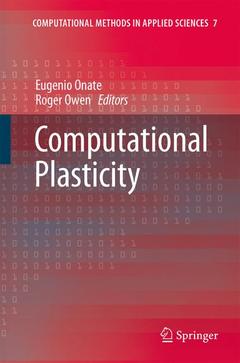Description
Computational Plasticity, 2007
Computational Methods in Applied Sciences Series, Vol. 7
Language: English
Subjects for Computational Plasticity:
Keywords
Analysis; CIM; Halle; composite material; concrete; mechanics; model; modeling; numerical methods; simulation; structure
Publication date: 10-2010
265 p. · 16x24 cm · Paperback
Publication date: 09-2007
265 p. · 15.5x23.5 cm · Hardback
Description
/li>Contents
/li>Comment
/li>
Despite the apparent activity in the field, the ever increasing rate of development of new engineering materials required to meet advanced technological needs poses fresh challenges in the field of constitutive modelling. The complex behaviour of such materials demands a closer interaction between numerical analysts and material scientists in order to produce thermodynamically consistent models which provide a response in keeping with fundamental micromechanical principles and experimental observations. This necessity for collaboration is further highlighted by the continuing remarkable developments in computer hardware which makes the numerical simulation of complex deformation responses increasingly possible.
This book contains 14 invited contributions written by distinguished authors who participated in the VIII International Conference on Computational Plasticity held at CIMNE/UPC (www.cimne.com) from 5-8 September 2005, Barcelona, Spain. The meeting was one of the Thematic Conferences of the European Community on Computational Methods in Applied Sciences (ECCOMAS, www.eccomas.org).
The different chapters of this book present recent progress and future research directions in the field of computational plasticity. A common line of many contributions is that a stronger interaction between the phenomenological and micromechanical modelling of plasticity behaviour is apparent and the use of inverse identification techniques is also more prominent. The development of adaptive strategies for plasticity problems continues to be a challenging goal, while it is interesting to note the permanence of element modelling as a research issue. Industrial forming processes, geomechanics, steel and concrete structures form the core of the applications of the different numerical methods presented in the book.




